By Jonathan Duffy, Arctic Meta
One thing is certain about Iceland; it’s had a fiery past and present and will continue having a fiery future.
In comparison to a lot of landmasses on the planet, the island of Iceland is young. Its story began 60 million years ago when a ridge in the ocean opened up and began expelling masses of molten lava.
This lava cooled and became rock, and over millions of years, this little island in the North Atlantic began to poke its head out of the sea.
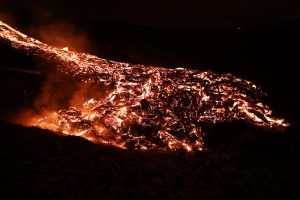
Today the oldest parts of Iceland that are still above sea level are only 16 million years old, and most of the country still experiences both volcanic and seismic activity. That being said, it’s not like Iceland is the living embodiment of Dante’s Inferno.
Mystical black sand beaches, pristine waterfalls, snow-capped glaciers and green moss lava fields all have an interconnected relationship with volcanoes. Iceland and its people have existed peacefully alongside these potentially explosive wonders since day one.
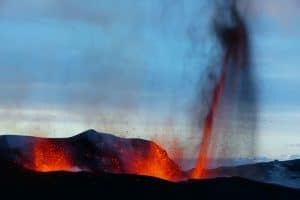
Ever since Ejyafjallajökull stopped erupting in 2010, many Icelanders have turned their attention to some of the 130 plus active volcanoes in the country and wondered, ‘Which one is next?’
The wait is over because there’s a new act in town taking centre stage not far from the capital of Reykjavík.
So it’s with great pleasure we welcome our next volcanic wonder. Put your hands together for Geldingadalir!
When Did the Eruption at Geldingadalir Start?
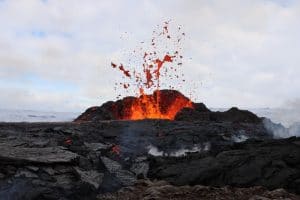
The beginnings of the eruption actually started long before lava began flowing. From December 2020, people in Reykjavík and the surrounding areas began experiencing intense earthquakes.
Seismic activity is a common occurrence in Iceland due to the country’s geological position, straddling the North American and Eurasian tectonic plates. However, throughout this period, swarms of earthquakes began.
An earthquake swarm is when lots of earthquakes happen in the same place over a relatively short time. Earthquake swarms can often signify that an eruption is coming, so when this started, it had most Icelanders wondering when a volcano would erupt.
It took another few months of ground rumbles before the first drops of lava broke the surface of the Earth’s crust on March 19, 2021, at 8:45pm. By the time the eruption happened, more than 50,000 tremors had been recorded.
The Formation of Geldingadalir Volcano
The eruption that began on March 19 took place in the Geldingadalir Valley. This is on the Reykjanes Peninsula, a volcanic region of Iceland just south of the capital city of Reykjavík. Reykjanes is also home to Keflavík International Airport and the famous Blue Lagoon Spa.
Geldingadalir’s name means ‘The valley of the geldings’ (male horses that have been castrated). The first eruption happened at the Fagradalsfjall mountain. This is an active volcano that has been silent for 6000 years, and it’s the first eruption in the area in 800 years.
Further Info: Icelandic Band Kaleo Film Music Video at an Erupting Volcano
The eruption was effusive. This is a kind of eruption where lava flows steadily onto the ground. So imagine it more like a leak from an underground drain pipe that spills onto a flat road. The initial lava field covered roughly a square kilometre and flowed at a rate of 13 meters per second.
Because Fagradalsfjall is effusive, it means it doesn’t really pose much of a threat to people or their way of life. The 2010 eruption of Eyjafjallajökull halted air traffic across Europe because it was very explosive. It threw rock, debris and volcanic ash high into the atmosphere.
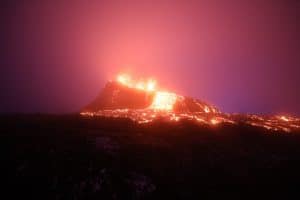
Over time as more lava spilt and began to cool, the area morphed into a growing, tall crater. Eventually, another opening appeared, and currently, there are two distinct conical craters spilling lava in the surrounding area.
How Can I Visit the Geldingadalir Volcano?
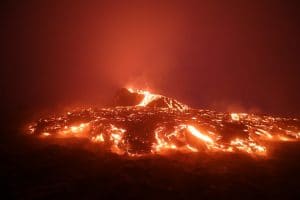
There’s a couple of ways you can get to see the volcano. You could travel there yourself, book a tour or see it from the sky in a helicopter.
What Tours Can I Book to See the Volcano
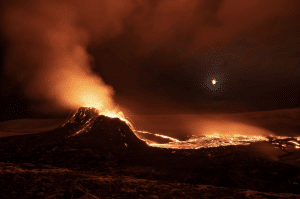
Picture: Privately Guided Tour to Erupting Volcano in Iceland
There are a few benefits to taking a tour to see the volcano. Although there are visible trails and signs marking the safest route to Geldingadalir, it’s important to remember that it’s an active volcanic site, so it’s constantly changing.
For example, the original path people took when the eruption first began no longer exists because it’s now buried underneath a sea of lava. Taking a tour will mean that you take all the guesswork out of the situation.
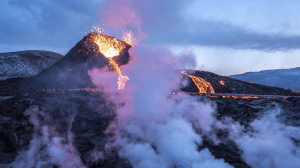
Picture: Hike to Erupting Volcano | Small-Group Tour with Free Photos
Sometimes the volcano is closed to the public due to the levels of gasses being too toxic to be around. The rules and regulations around being a guide in Iceland are very strict. This means any professional guide is always aware of the current conditions and how they are affected by weather and temperatures.
There are some great guided tours like this hiking one that includes free photos. You could also choose to take a private tour that leaves from Reykjavík or the town of Grindavík if you want something a bit more exclusive and intimate.
Helicopter Tours of Geldingadalir Volcano
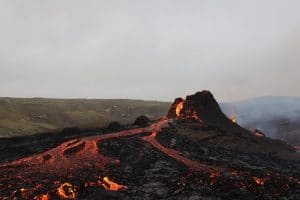
As mentioned earlier, the kind of eruption at Geldingadalir isn’t disruptive to air traffic. This means that aircraft can actually fly over the site, which can give you an entirely different view of a once in a lifetime image.
Norðurflug offers regular helicopter tours of the eruption, leaving from Reykjavík Domestic Airport. There are other companies also offering tours like this, including Volcanoheli and ViajessIslandia. Keep in mind these tours can only take small numbers of people, and some of them are booked well in advance, so get in early to secure a spot.
Where is Geldingadalir Volcano?
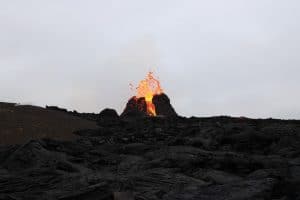
Geldingadalir is located in the Reykjanes Peninsula. It’s about 58km south of Reykjavík, and depending on traffic, you can drive there in about an hour. If you are looking for it on google maps, it’s probably better to search for Fagradalsfjall and not Geldingadalir because there’s a place similarly named (Geldingadalur) 2 hours North of Reykjavik.
It’s also worth noting that the volcano is only about 2 hours drive from the Panorama Glass Lodge. So if you are planning on staying here, you can easily make a day trip out to see the eruption and be back in time to unwind in the comfort of the pristine South Coast.
How Can I Get To Geldingadalir Volcano?
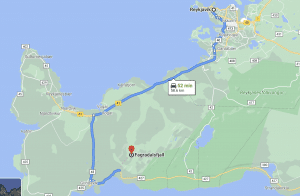
Info: Map of the journey from Reykjavik to Geldingadalir
To get there by car from Reykjavík, you need to head towards the town of Grindavík. You do this by taking route 41, which is the same road you would take to get to Keflavík International Airport. Instead of going to the airport, keep heading to Grindavík. Once you arrive in the town, you will take a left onto route 427.
Then follow route 427 till you have reached the car parks for the eruption site. The car parks are paid and currently cost around 1000 isk, which is a very reasonable price in Iceland and covers you for the whole day.
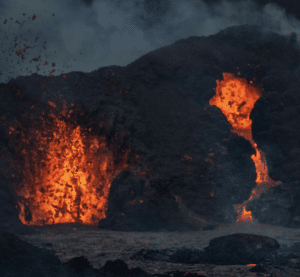
Picture: @frozenbritabroad
Over 30% of the Icelandic population have now taken the walk, and it’s understood to be relatively easy for people of most hiking abilities. You can expect up to an hour of hiking with some inclines until you get your first glimpse of the volcano.
Pay attention to signs and stick to the designated walking path for your safety. Remember that this is an active volcanic site. The landscape around the area is constantly changing.
What Should I Bring On a Hike to Geldingadalir Volcano
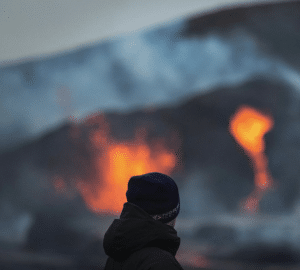
Picture: @frozenbritabroad
Although it’s a relatively easy hike, there are some things you can bring with you that will ensure your safety, comfort and overall make your volcano experience more enjoyable.
Take it from a local who has been to the eruption site; waterproof clothing is a must. It rains a lot in Iceland, and even on a relatively warm day, the temperature is still generally between 10℃ and 18℃. If you get wet at these temperatures, you can very quickly become incredibly uncomfortable or even run the risk of developing hypothermia.
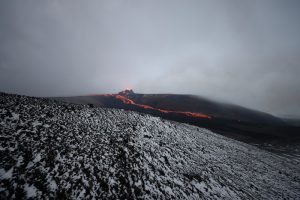
A waterproof backpack can also be a real game-changer on a hike like this; it will help keep your electronics like phones and cameras safe from the elements.
Hiking sticks can be helpful for inexperienced hikers, but the most important thing is to have decent hiking shoes. Something with a good level of grip that is once again waterproof will help keep you from slipping and keep those toes dry.
Bring water and snacks with you. An hour-long hike can burn anywhere between 600 and 1000 calories. Many people take things like bananas, oat bars or nuts with them. Things that keep for a while and are easy to snack on the go.
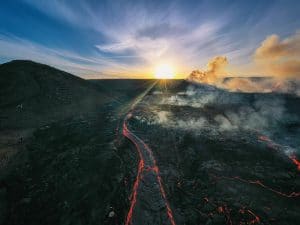
Even if you don’t get hungry during the hike, water is essential. There’s no place to drink once you have left the car park, so you should bring plenty of water to stay hydrated.
Also, it’s important to make sure you leave the volcano site as you found it. Yes, the lava will melt everything in its path, but that doesn’t make it a garbage disposal. Icelanders are very proud of the pristine nature the country has to offer, and it’s up to all of us to make sure it stays that way for many years to come.
What is the Best Way to Photograph an Erupting Volcano
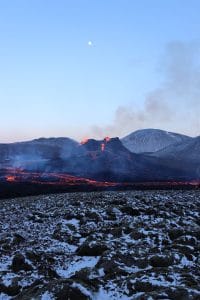
The best way to photograph an erupting volcano is to make yourself comfortable and have fun playing with your camera settings till you get something you like. If you want to catch the lava as it jumps in the air, you should use a fast shutter speed. Think something like c 1/1000 as a minimum.
You could also get a bit more arty and experiment with long exposure, like 2-3 seconds, to make the lava look like swirling lines.
What Camera Equipment Should I Bring?

A tripod is a must if you want to get some great shots of a volcano, and it’s also worth making sure your equipment is sturdy and can handle the conditions of the area. Be aware that the closer you get to the volcano, the more heat you will be exposing your camera to.
For lenses, you’re going to want to bring a mid focal length and a long-distance lens. I would probably go with something like a 70-200mm lens. It’s better to have picked your lens before you arrive. This way, you aren’t changing it in the field, resulting in volcanic ash getting into your camera and causing damage.
Volcanic ash is far more abrasive than regular dust and dirt, so the more protection your equipment has from it, the better. A good UV filter on the end of your lens will also help protect it from ash-caused scratches.
If you plan on using a drone, do so at your own risk. The volcano has already eaten dozens of them. If your drone falls while getting a fantastic shot, you’ll just have to say goodbye because the floor is literally lava.
How Long Will Geldingadalir Erupt For?
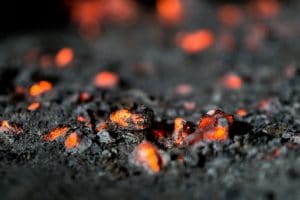
In volcanology, this is the proverbial million-dollar question. The Icelandic Met Office has stated that it’s hard to tell how long Geldingadalir will erupt. They can only make an educated guess based on the data they already have.
Due to the slow rate of lava flow and the fact that it’s an effusive eruption, it looks as though it might eventually turn into a shield volcano. Shield volcanoes are large, gently sloping volcanoes that form over long periods.
Experts can only really say that they think this eruption will be long-lasting. That could mean a couple of months or even years. A similar eruption began at a place called Eldgjá in 930 AD and didn’t stop for 8 years.
Conclusion
If you can get to Iceland at all to see this eruption, you won’t be disappointed. Geldingadalir is one of the safest volcanic eruptions people can visit and is an incredible reminder of the otherworldly beauty Iceland has to offer.
Seeing a volcanic eruption in real-time is something few people on this planet ever get to experience, but it’s also not the only thing like this in Iceland. The entire country is filled with so many natural wonders unique to this corner of the globe.
They’re all here waiting for you to explore them.
